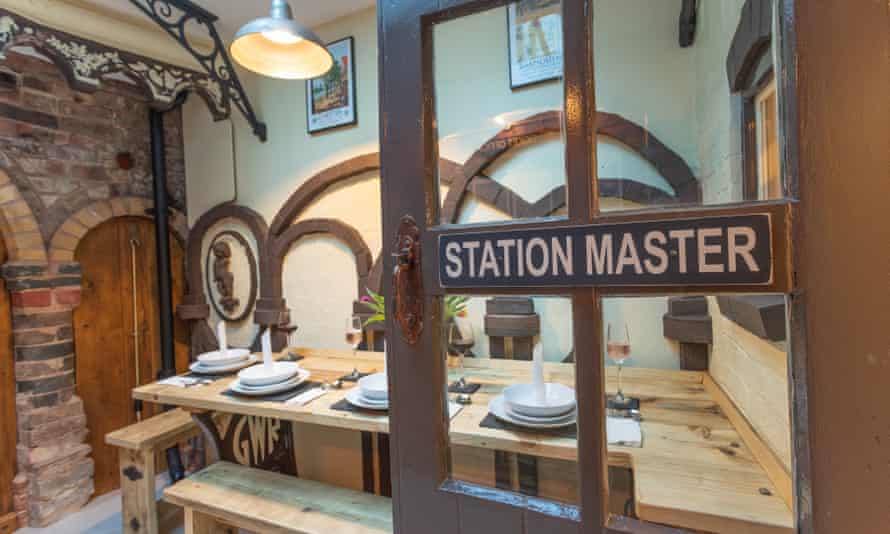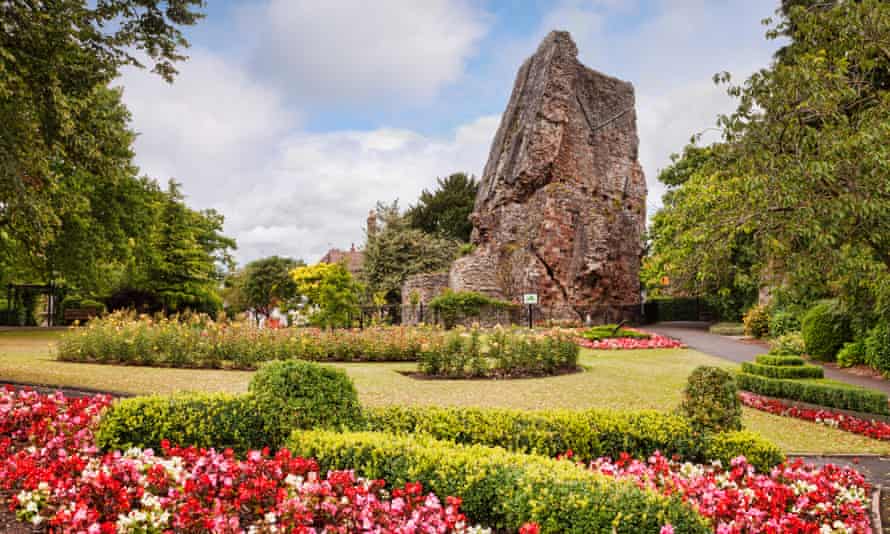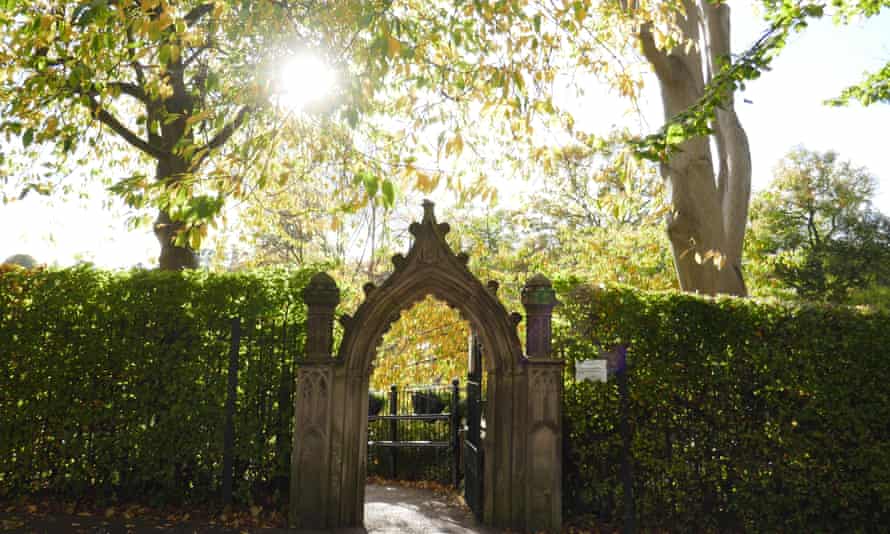Bridgnorth has one of England’s oldest cliff railways, a holiday cottage with a hidden cave and a tower that leans more than Pisa’s. But I’ve been drawn to south-east Shropshire by the prospect of bracing winter hikes, friendly pubs and a trip to the sights of Shrewsbury. I arrive in Bridgnorth by bus from Wolverhampton (£3.90). The steep, atmospheric cliff railway (£2 return) carries me up to the High Town just as a rainbow arcs across the valley below.
There are views across the River Severn to wooded red cliffs from nearby Castle Walk, which leads to the 18th-century church of Saint Mary Magdalen, designed by bridge-builder and engineer Thomas Telford. The sandstone castle next to it was blown up by Roundheads and now leans at 15 degrees – four times the angle of the tower of Pisa – among bright beds of begonias.
The impression of colour and eccentric angles continues as I step off steep, curving Railway Street into the Alice-in-Wonderland sitting room of Dracup’s Cottage, where I’m staying. There’s a patchwork sofa, a crooked mirror and a clock that runs backwards, but this room is merely quirky. The rest of the cottage is a masterclass in idiosyncrasy, from the steampunk bathroom to the surreal murals in one upstairs room: it’s a Hieronymus-Bosch-style Bridgnorth landscape with contortionists, naked hot-air ballooners and a giant carnivorous chameleon.

The artist Antony Dracup lived in this old railway cottage for decades; Karolina and Jason Harte bought it in 2019 and have spent two years doing it up. I open a door at the back of the cottage to find medieval music playing in a gothic pillared vault lit by flickering candles. Dracup chiselled this space out of the sandstone hillside and used the excavated sand to create bricks for the supporting arches.

The station-themed kitchen is inspired by the Severn Valley Railway, a few steps down the hill. The full-size, mostly steam-hauled line runs for 16 miles between Bridgnorth and Kidderminster. It’s great for linear walks along the long-distance Severn Way. I’ve hit a seasonal lull in the train timetable so catch bus 297 instead, passing through the woods around Dudmaston Hall. I get off in the village of Alveley and walk down Chapel Lane into the Severn Valley country park.
There are clear views of the Clee Hills, including Shropshire’s highest peaks, topped with iron age forts or radar scanners. Until 1969, the park was a mine, producing 300,000 tons of coal a year at its height. A new history trail, opened in 2020, passes traces of ropeways, spoil heaps and miners’ cottages. Today the wooded paths are thick with birds and berries: I spot a rust-red-slate-grey chaffinch and a flock of long-tailed tits. There are wreaths of orange bryony twisted through yellow hedges spangled with neon-pink spindle berries. I follow the trails to a footbridge over the rain-swollen Severn.
Bridgnorth is eight miles upstream and the riverside path is grassy and inviting, with mossy hawthorn trees and huge gaggles of mallards. There are signs of fierce flooding: bundles of reeds are lodged in upper branches, and snagged and ragged sheets of polythene flap in the racing current like Halloween ghosts. At the hamlet of Lower Forge, halfway to Bridgnorth, you can leave the river and catch bus 125, passing Eardington nature reserve, once a sand and gravel quarry, and Daniel’s Mill, a working 18th-century watermill near the Severn Valley Railway viaduct.

For supper, I go to the Royle, a half-timbered pub and restaurant on Bridgnorth’s High Street. It’s a weeknight but the place is buzzing. Landlords Chris and Anna Walsh built up a following during their years at the King’s Head over the road. At the Royle, Chris is both affable pub landlord and knowledgable restaurant host. The food is hard to fault: three crisp and delicate bhajis under cucumber ribbons and coriander leaves and a rich salmon wellington with a layer of shallots and mushrooms.
Bridgnorth’s friendliness is remarkable. As I’m having breakfast outside Coffee at d’Arcy’s next morning, several passing strangers say hello. I meet Sally Themans, founder of community group Love Bridgnorth, to talk about the town’s thriving high street. She’s just come from the opening of a new artisan jewellery shop. The streets nearby are fizzing with eco-friendly, independent shops: you can fill your own pot with nuts or lentils at Room for Refills, or head to Roobarb over the road for a bobble hat with its fleecy lining recycled from old plastic bottles.
I catch bus 436 to Much Wenlock (£2.70 single) and spend the day striding on ancient stony tracks along the limestone cliff of Wenlock Edge through flaming gold beeches and yellowing hazel trees. The same bus, next morning, carries me all the way to Shrewsbury past views of the isolated Wrekin. Shropshire’s river-circled county town has lots of options for all-weather sightseeing, including a good market. You can stash bags at the Premier Inn near the station for £6.

Simon Jenkins names three Shrewsbury churches in his England’s Thousand Best Churches and I duly admire the octagonal tower and circular nave of Georgian Saint Chads and the Norman doorway of the red sandstone abbey with its mix of windows above. “Seven lights rise to Perpendicular panel tracery, fracturing into Decorated reticulation,” Jenkins writes. Sure, but is there a cafe? Saint Mary’s, a soaring town-centre beauty, caters for both soul and body. I have a coffee and watch multicoloured light pour through six centuries of stained glass on to Victorian floor tiles under a carved oak ceiling.
Next up is the town’s free museum and art gallery, a neoclassical former concert hall that counts Telford’s measuring wheel among its treasures. Natural images recur through the millennia: flowers on a silver Roman mirror, ravens on a carved Tudor four-poster, butterflies on fine Caughley porcelain. Nearby Okra, a vegan cafe opened in October 2019, does salads and noodle bowls. My warm flatbread (£7) is sliced through, revealing a fresh rainbow of green leaves, carrot, red cabbage, roasted aubergine, chickpeas and chutney.

After lunch, I walk through the Dingle, a bench-lined garden in a former quarry, down an avenue of lime trees, and over the disconcertingly bouncy Port Hill suspension footbridge. The Boathouse pub, on the far side of the Severn, serves Darwin’s Origin copper ale from the Salopian Brewery. (Charles Darwin was born in Shrewsbury). It takes 15 minutes to stagger from here along the river to the station, past a Darwin-inspired riverside archway called Quantum Leap. The trains home run smoothly while a pink sunset glows and fades to black outside the windows.
Train travel to Wolverhampton was provided by Avanti West Coast (advance tickets from £10.80). Accommodation was provided by Dracup’s Cottage (sleeps two from £125 a night, two-nights minimum, dracupscottage.co.uk). More information at visitshropshire.co.uk





